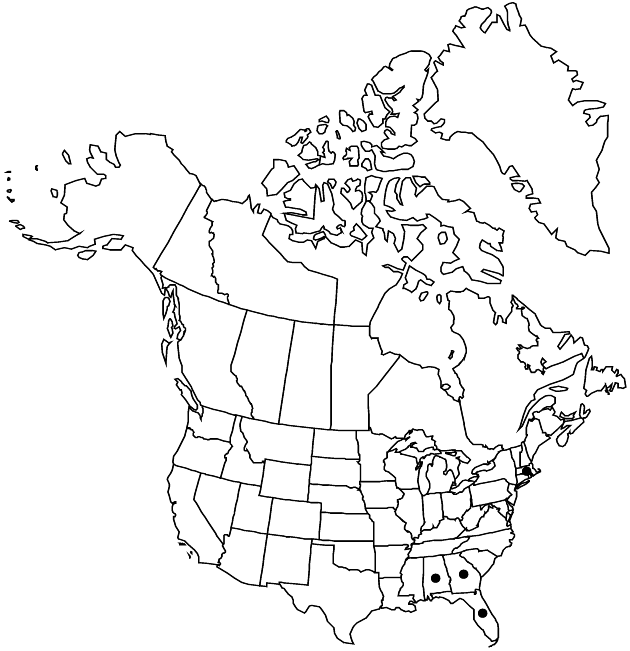Difference between revisions of "Flaveria bidentis"
Revis. Gen. Pl. 3([3]): 148. 1898.
FNA>Volume Importer |
FNA>Volume Importer |
||
| Line 27: | Line 27: | ||
|elevation=0–10 m | |elevation=0–10 m | ||
|distribution=Ala.;Fla.;Ga.;Mass.;West Indies;Central America;South America;also introduced in Europe (Great Britain) and Africa (Egypt and south). | |distribution=Ala.;Fla.;Ga.;Mass.;West Indies;Central America;South America;also introduced in Europe (Great Britain) and Africa (Egypt and south). | ||
| − | |discussion=<p>In the United States, Flaveria bidentis often occurs on ballast and waste ground near wharfs and the shore, locations that suggest its introduction from sailing vessels. The species is widespread and well established in South America, where it is thought to be native. Its floral structure appears to be the least advanced among the annual species of Flaveria, the heads being in somewhat scorpioid arrays. Distinguishing characteristics are 3(–4) phyllaries, 2–8 florets per head, reduced ray corollas, pubescent stems, and lanceolate-elliptic, bluish green, sometimes pubescent leaves. Flaveria bidentis is probably most closely related to F. campestris and F. trinervia.</p> | + | |discussion=<p>In the United States, <i>Flaveria bidentis</i> often occurs on ballast and waste ground near wharfs and the shore, locations that suggest its introduction from sailing vessels. The species is widespread and well established in South America, where it is thought to be native. Its floral structure appears to be the least advanced among the annual species of <i>Flaveria</i>, the heads being in somewhat scorpioid arrays. Distinguishing characteristics are 3(–4) phyllaries, 2–8 florets per head, reduced ray corollas, pubescent stems, and lanceolate-elliptic, bluish green, sometimes pubescent leaves. <i>Flaveria bidentis</i> is probably most closely related to <i>F. campestris</i> and <i>F. trinervia</i>.</p> |
|tables= | |tables= | ||
|references= | |references= | ||
| Line 52: | Line 52: | ||
|publication year=1898 | |publication year=1898 | ||
|special status= | |special status= | ||
| − | |source xml=https://jpend@bitbucket.org/aafc-mbb/fna-data-curation.git/src/ | + | |source xml=https://jpend@bitbucket.org/aafc-mbb/fna-data-curation.git/src/8f726806613d60c220dc4493de13607dd3150896/coarse_grained_fna_xml/V19-20-21/V21_617.xml |
|tribe=Asteraceae tribe Heliantheae | |tribe=Asteraceae tribe Heliantheae | ||
|subtribe=Asteraceae (tribe Heliantheae) subtribe Flaveriinae | |subtribe=Asteraceae (tribe Heliantheae) subtribe Flaveriinae | ||
Revision as of 15:36, 18 September 2019
Annuals, to 100 cm (delicate or robust, sparsely villous). Stems erect. Leaves petiolate (proximal, petioles 3–15 mm) or sessile (distal); blades lanceolate-elliptic, 50–120(–180) × 10–25(–70) mm, bases (distal) connate, margins serrate or spinulose serrate. Heads 20–100+ in tight subglomerules in scorpioid, cymiform arrays. Calyculi of 1–2 linear bractlets 1–2 mm. Involucres oblong-angular, 5 mm. Phyllaries 3(–4), oblong. Ray florets 0 or 1; laminae pale yellow, ovate-oblique, to 1 mm (not or barely surpassing phyllaries). Disc florets (2–)3–8; corolla tubes ca. 0.8 mm, throats funnelform, 0.8 mm. Cypselae oblanceolate or subclavate, 2–2.5 mm (those of ray florets longer); pappi 0. 2n = 36.
Phenology: Flowering year round.
Habitat: Moist places, waste or disturbed ground, clay, gravel, or sand
Elevation: 0–10 m
Distribution

Ala., Fla., Ga., Mass., West Indies, Central America, South America, also introduced in Europe (Great Britain) and Africa (Egypt and south).
Discussion
In the United States, Flaveria bidentis often occurs on ballast and waste ground near wharfs and the shore, locations that suggest its introduction from sailing vessels. The species is widespread and well established in South America, where it is thought to be native. Its floral structure appears to be the least advanced among the annual species of Flaveria, the heads being in somewhat scorpioid arrays. Distinguishing characteristics are 3(–4) phyllaries, 2–8 florets per head, reduced ray corollas, pubescent stems, and lanceolate-elliptic, bluish green, sometimes pubescent leaves. Flaveria bidentis is probably most closely related to F. campestris and F. trinervia.
Selected References
None.